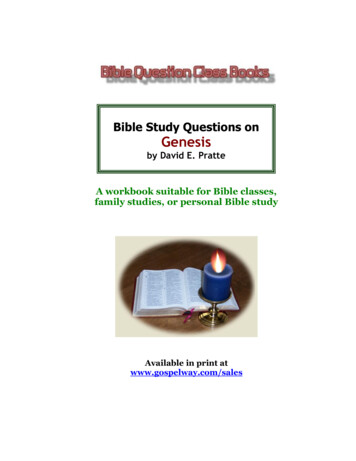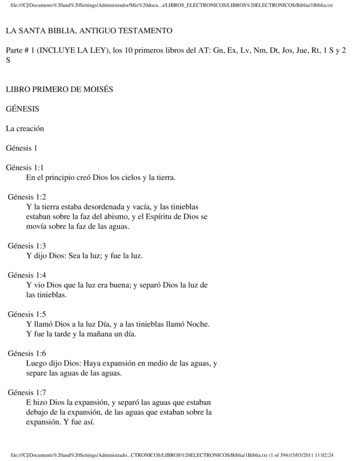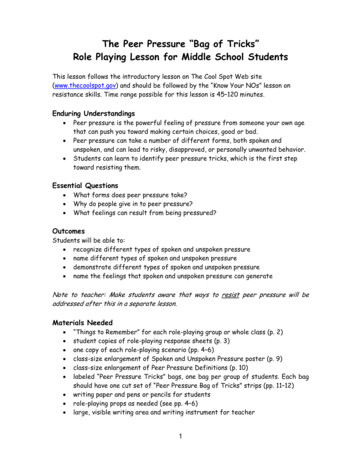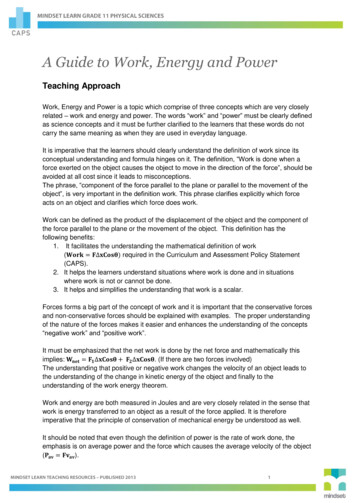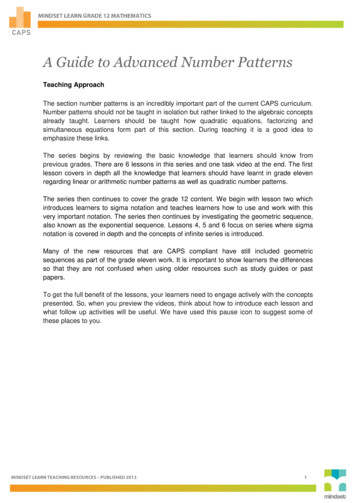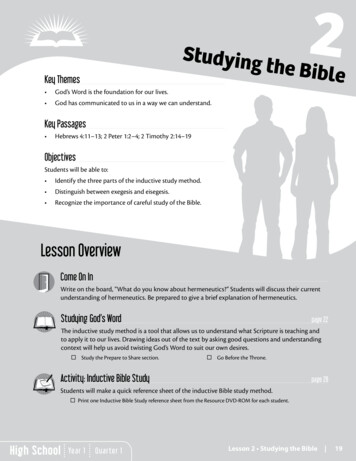
Transcription
Studyingth2e BibleKey Themes God’s Word is the foundation for our lives. God has communicated to us in a way we can understand.Key Passages Hebrews 4:11–13; 2 Peter 1:2–4; 2 Timothy 2:14–19ObjectivesStudents will be able to: Identify the three parts of the inductive study method. Distinguish between exegesis and eisegesis. Recognize the importance of careful study of the Bible.Lesson OverviewCome On InCOME ON INWrite on the board, “What do you know about hermeneutics?” Students will discuss their currentunderstanding of hermeneutics. Be prepared to give a brief explanation of hermeneutics.Studying God’s Word STUDYING THE WORDpage 22The inductive study method is a tool that allows us to understand what Scripture is teaching andto apply it to our lives. Drawing ideas out of the text by asking good questions and understandingcontext will help us avoid twisting God’s Word to suit our own desires. Study the Prepare to Share section. Go Before the Throne.Activity: Inductive Bible Study page 28Students will make a quick reference sheet of the inductive Bible study method.ACTIVITY–ADULTHigh SchoolPrint one Inductive Bible Study reference sheet from the Resource DVD-ROM for each student.Year 1Quarter 1Lesson 2 Studying the Bible 19
Prepare to SharePREPARE TO SHARE20 Scriptural Backgroundor make it conform to our thoughts. We are to submitourselves to the Scriptures, not the other way around.God has revealed Himself to us in the words ofthe Bible—His only written revelation to man. We arecalled to study diligently what has been revealed andto apply it to the way we live our lives. Within thepages of Scripture, we find many exhortations to usewhat God has revealed in a way that honors Him.In the Old Testament, we find examples of the Israelites abandoning what God had revealed to them. Asa result, the people of that nation became corrupt.We see in Nehemiah 8 the reading of the book ofthe Law of Moses before the assembly of Israel after ithad been neglected for so long. Hearing the words,the people again understood what God required ofthem and sought to live accordingly.Jesus chided the scribes and Pharisees for theirfailure to understand what God had revealed. “Haveyou not read?” was His way of pointing out their misunderstandings (Matthew 12:3–5, 19:4, 22:31). Theyhad added their own ideas into the Scriptures ratherthan seeking to understand the plain meaning.As Jesus taught, He constantly referenced theScriptures as authoritative for guiding our lives. Thatsame idea persisted as the apostles and disciples continued to spread the gospel after Christ’s ascension.In Acts 17:10–12, we read of the Bereans, whowere commended for searching the Scriptures to confirm what Paul was teaching.In the New Testament epistles, there are manyexamples of examining the Bible to understand thetruth. For example, in Hebrews 4:11–13, we are toldthat the Bible is like a sword that helps us discern truthfrom error in our thoughts. And Paul exhorted Timothy to study diligently God’s Word in order to discernwhat is true (2 Timothy 2:14–19).We trust that God has revealed to us those thingsthat we need to live lives that honor Him. Peter relatesthis idea to us in 2 Peter 1:2–4 when he tells us that“all things that pertain to life and godliness” have beengiven to us “through the knowledge of Him.” How dowe know about God? We know primarily by what Hehas revealed to us in His Word. The doctrine knownas the sufficiency of Scripture doesn’t mean that theBible is an exhaustive manual on everything, but thatits principles are sufficient to guide us in the differentsituations we face.In this lesson, we will teach the three-step inductive study method which will then be used throughoutthis curriculum to discern what the text of Scripturesays. Laying such a foundation is critical if we are tostudy the Bible in a way that will not distort the textApologetics BackgroundLesson 2 Studying the BibleMany people chide Christians for reading theBible literally. The Bible contains many different typesof literature, but all of them communicate God’s truthto us. When we say we take the Bible literally, wereally mean that we take it in the sense that it waswritten. Some sections of Scripture are meant to beread as historical accounts, while others are poetic.The process of understanding what Scripture saysis called hermeneutics––a big word describing theprocess of trying to understand what the Bible means.Learning proper hermeneutics opens a whole newworld of truth found in the Bible. There are many different schools of biblical interpretation. These rangefrom liberal approaches (mystical interpretation, naturalistic interpretation, etc.) to the more conservativeapproach we’ll be using (where ideas are consideredin context and Scripture is used to interpret Scripture).This second, more conservative method may be newto you. It is often referred to as the grammatical-historical method of interpretation because it takes intoaccount the grammar and context of the passage aswell as the historical and cultural setting of the authorand the original hearers. We will call it the inductiveBible study method.As Christians, we recognize that the Bible isGod’s very breath revealing His words to us. As weseek to understand what He has said, we should notimport our own ideas into Scripture but rather allowScripture to inform and evaluate our ideas. Drawingideas out of the text is called exegesis (ex- meaning“out of”), while adding our ideas into the text is calledeisegesis (eis- meaning “into”).Take Genesis 1 for example. If we simply read thatchapter as it is plainly written, we would concludethat God created the universe in six normal days—anaccurate exegesis. On the other hand, if we considerthat same text by starting with a belief in evolutionaryprocesses occurring over millions of years, we mightbe tempted instead to interpret those “days” as longages. In that case, we would engage in eisegesis sincewe imported the idea of long ages into the text––apractice that can lead to the dangers of compromiseand distorted conclusions.In order to properly exegete a passage, we followthree essential components in an inductive Biblestudy: observation, interpretation, and application.These steps can be subdivided in various ways, butwe will stick to three basic parts to teach the process.
To observe, we simply ask who, what, where,when, why, and how questions about the study passage. Who is the author writing to? What words arerepeated or emphasized in the passage? Where isthe event taking place? When was this written? Whattype of literature is being used (history, poetry, parable, etc.)? What is the main point of the passage?By taking time to observe the text, we becomefamiliar with the important words, commands, andmain themes that are present. Once we are familiarwith the passage, we are ready to interpret what wehave read.To interpret, we look at the passage in light ofwhat the rest of the Bible has to say on the sametopic. We may identify cross-references, culturalconsiderations, specific word meanings, context,commentaries, or parallel passages that tell of thesame account or provide the same idea. We shouldbe careful during the interpretation stage becausethere is always the danger of trying to read our ownideas into the text.After we have observed what the text says andinterpreted the key ideas, the next step is to applythe Word to daily life. Scripture is full of God’s commands to believers to apply what He has communicated—we are to be doers of the Word, not justhearers (James 1:21–24). We know from 2 Timothy2:14–19 that Scripture is to be the source of truth inour lives.As we examine various texts, our goal will be tohelp the students see that the Scripture is profitableto them when they apply the passage’s teaching toone or more of the four areas identified in 2 Timothy3:16–17: Doctrine (understanding of fundamental beliefs) Reproof (pointing out sin) Correction (identifying right actions) Instruction in righteousness (living by God’scommands and principles)The Word may expose an error in their thinkingor a flaw in the way they are living and thus presentan opportunity to repent of those sins and to be conformed to the image of Christ.In summary, right theology leads to right living.We can praise God for the grace He has shown usby saving us and sanctifying us. We can ask Him tomature us and change us into the image of His Sonthrough the power of His Spirit.Historical BackgroundEvangelical tradition is built on the understanding that every Christian can read and understandGod’s Word. The fancy term for this idea is the perspicuity of Scripture. The reformers fought to makethe Bible available in the language of the people—aprivilege we enjoy today––in stark contrast with theteaching of other groups who historically opposedthe idea.The fear that motivated this opposition was thatpeople would take the Bible and misunderstand andmisapply it. This has indeed happened on occasion,but those who distort the Scriptures do so “to theirown destruction” (2 Peter 3:14–18). Many cults andfalse religions have been founded on careless use orintentional distortion of the Bible. This makes it allthe more important that we handle the Word carefully as God would have us do.For more information on this topic, see theOnline Resource Page.Before the ThroneLord, your Word is a precious treasure. Please guide me to rightly study itand to discern your message accurately.And please help me to present this lessonin a way that my students will learn how toproperly study your Word. Please help meto be responsive to the guidance I discoverand to be willing to turn from any impurities I discover in my life when studiedin the light of your guidelines. Draw thestudents in my class to love your Word,believe it, and allow it to guide their lives.BEFORE THE THRONE Pace your lesson! You can use the provided clocks to indicate the time each section should becompleted to keep the lesson on schedule. While teaching, you can compare youranticipated times with the actual time and shorten or drop sections as necessary.10:30Lesson 2 Studying the Bible 21
ReviewREVIEWLast week we talked about how the Bibleshould be the starting point for all of ourthinking. We looked at several passages inPsalms that described God’s Word. Psalm19:7–11, 86:11, 119:105.can tell me some of the things God’süü WhoWord was compared to or how it wasdescribed? Perfect, sure, righteous, more desirablethan gold, sweeter than honey, a path, a lamp. Write on theboard, “What doyou know abouthermeneutics?”Students willdiscuss their currentunderstanding ofhermeneutics.We also discussed how everyone looks atthe world around them. We refer to thisas a person’s worldview.analogy did we use to describe howüü Whatwe look at the world around us?Everyonelooks through “glasses” of somesort. Christians should belooking at the world through“biblical glasses.”Studying God’s WordSTUDYING THE WORDToday we are going to look at how to read and study the Bible effectively.Since the Bible is the Word of God given to us, we are responsible forunderstanding what it has to say to us. The Bible is not open to justany interpretation we want—it has a specific meaning. God has clearlycommunicated His will to us, and we can come to understand Him as westudy Scripture. We will be talking about hermeneutics today. That is justa fancy word for how we study the Bible in order to correctly understandwhat it teaches.Read the Word2 Peter 1:1–4Let’s read the following passage together: 2 Peter 1:1–4. Have someone read thepassage as the others follow along. Encourage everyone to bring a Bible and to be ready to use it.Examine the WordNow that we have read the text, let’s take some time to observe what itis saying to us. This process is an important part of understanding whatGod’s Word is telling us. We will be using a three-step process of observingwhat the text says, interpreting the ideas, and then applying them to ourlives. Write these three steps for everyone to see, or refer to the Bible Study poster.This method is called inductive Bible study since we are looking at thespecific parts of the text and then drawing general conclusions from theparticulars. This makes us listen as the text speaks to us rather than ourcoming to conclusions and then trying to find Bible verses that supportour ideas. We always want to start our reasoning from God’s Word. Let’sstart the process with this passage.22 Lesson 2 Studying the Bible
Observe the TextWe are going to start by asking some simple questions. This will help us tocarefully observe the text and help us avoid adding our ideas into the text.üü Who is writing this letter, and who is it written to?The Apostle Peter is writing thisletter to other Christians. We know this is the audience because they “have obtained like preciousfaith” by Christ’s righteousness.There are many different styles of literature in the Bible. It contains poetry,history, parables, prophecy, and other types of writing.üü What form of literature is 2 Peter?üü Are there any phrases or words that are repeated?üü What is the historical context of this passage?üü What commands, promises, or warnings are in this passage?This is an epistle—a letter written to Christians toencourage them and provide doctrinal teaching and correction.God and Jesus are repeatedseveral times—God is the focus of the passage.It was written in the first century.There are nocommands or warnings, but there are several promises. Verse 1 talks about the righteousness wehave in Christ. Verses 3 and 4 talk of the promises we have been given and the knowledge of Godthat allows us to live godly lives.üü What has been given to Christians according to this passage?We have beengiven all things that pertain to life and godliness (verse 3) and great and precious promises (verse 4).We can continue to ask lots of questions about the text in order tounderstand everything within the passage, but we will move on for nowand continue in the process. The next step, now that we have madeobservations, is to start interpreting the passage so that we can apply it toour lives. The interpretation process will help us understand the passagein light of the rest of Scripture and identify the main idea of the passage.Refer to the Bible Study poster as you discuss the different parts of the process.üü Verse 3 uses two pronouns. To whom are these pronouns referring?“His”and “Him who” refer back to God—the Father and Jesus in verses 1 and 2.In verse 3, we see that God’s divine power is the source of the thingsthat pertain to life and godliness through the knowledge of Him. Thisraises the question of how we can know about God so that we mightunderstand those things mentioned. To understand what this means, wemight ask the following question.üü How do we find “the knowledge of Him [God]”?God has revealed Himself in thepages of the Bible. As we study the Bible, we learn more about God and can understand how we areto live. Within the pages of Scripture, we find God’s commands and the expressions of His character.As we understand who God is and what He has called us to do, we can live our lives in light of thatknowledge.This passage contains many more rich truths that we could continue touncover, but we are going to stop here for now and focus on the maintheme we have been looking at.Lesson 2 Studying the Bible 23
on the little bit of observation and interpretation that we have justüü Baseddone, what is the main theme we can draw from this passage?Students maysee other themes, such as the glory and virtue of Christ allowing us to be partakers in the divinenature, but the theme we are looking at is that we can understand how to live our lives in lightof what God has revealed to us in Scripture. We will support this idea as we look at the next twopassages. This is part of the doctrine known as the sufficiency of Scripture—one of the cornerstonedoctrines of the Christian faith.Discover the TruthNow that we have asked questions about the text, observing andinterpreting, let’s talk about the main idea of the passage. The idea thatGod has given us all things that pertain to life and godliness shouldinfluence the way that we live our lives.üü How do we live our lives in light of this truth from Scripture?This truth shouldgive us great comfort in knowing that God has communicated with us so that we can live lives thathonor Him. We should look to God’s Word, trusting that it has answers forthe questions we face in our lives. His Word should be the place we look toas the final authority in every area of our lives.Read the WordHebrews 4:11–13Let’s read Hebrews 4:11–13 together. Have someone read the passage aloud.Examine the WordIn this passage, we are going to look at two more aspects of the inductivestudy method. In the previous passage we covered the three basic partsof the method. As we observe and interpret, we are going to look at theimportance of reading the text in the way the writer meant the text tobe understood. Many people say that they read the Bible literally, but wehave to be careful with that idea. When people outside the church hearthat phrase, they often use it to mock Christians. So we need to explainthe idea better.Jesus referred to Himself as a door in John 10:7, but we don’t think Hemeans He is a literal door with hinges and a handle. To read the Bibleliterally means we first recognize any figures of speech and what type ofliterature is being used and then interpret based on those elements. Thispassage has several figures of speech. Let’s see if we can identify them andfind the plain meaning of the passage.Observe the Textüü What does verse 12 use the phrase “word of God” to describe?This phrasemeans more than just a single word spoken by God. It is commonly used to refer to the completerevelation of God through history—the Bible.24 Lesson 2 Studying the Bible
any other passages of Scripture help us understand what this phraseüü Canmeans?Many other passages use this or similar phrasing to describe the revelation of God.Students may have cross-references or commentary notes in their Bibles. Have them look for otherpassages (as time allows) that communicate this idea. Some examples: 1 Thessalonians 2:13; Mark7:13; Luke 4:4; John 10:35.Using other passages to help understand what we are reading is a veryimportant part of Bible study. Examining parallel passages that giveanother telling of an account or identifying where the same idea or phraseis used leads us to a better understanding of the truths of God’s Word,the Bible. This is referred to as the analogy of Scripture—using Scriptureto interpret Scripture. Looking at parallel passages and cross-references isimportant to fully understand a passage.üü Looking back to verse 12, how is the Word of God described?the writer of Hebrews intend us to think that he was talking about aüü Didliteral sword?Living, powerful,and sharper than a two-edged sword.This phrase is a form of metaphor since a word cannot be sharp in the same waythat a sword is.there any other passages in Scripture that compare God’s words toüü Area sword?Ephesians 6:17 calls the word of God the sword of the Spirit. Revelation 1:16 and 2:12speak of a two-edged sword coming from the mouth of Christ. So we often refer to the Bible, whichis the very Word of God, as a sword.Discover the TruthUnderstanding how different figures of speech are used is important tounderstanding the meaning of a passage. Other passages of Scripture areoften helpful in understanding the plain meaning of the text. Readingthe Bible literally means looking at the plain meaning of a passage, notinterpreting every word in a strict sense and certainly not allegorizingeverything. This is often summarized in the phrase, “If the plain sensemakes sense, seek no other sense.” This is a good rule of thumb forinterpretation, though not a definite rule.light of what we have just looked at, what is the main theme of thisüü Inpassage?God’s Word is the standard for truth, and as a sword can divide physical things, thewords of God help us evaluate our actions in light of God’s standard. We will give an account forour actions, so we should look to the Bible for guidance. In the broader context of this passage,Christ has given us hope of salvation through what He has accomplished,and we are to live a life that honors what He has done for us.Read the WordWe are going to examine one more passage today. Some of you mighthave part of this passage memorized. As we mentioned earlier, it isimportant that we let the Bible speak to us rather than adding ourown ideas into the Bible. We should not go looking for Bible verses thatLesson 2 Studying the Bible 25
support our opinions, but we should start from God’s Word to inform ourthinking—in every area of life.This is the difference between two Greek words that are often used:exegesis and eisegesis. When we practice exegesis, we are drawing ideas“out of” (i.e., ex-) the text. Eisegesis is the opposite idea—adding ourown ideas into the text. Taking our modern or personal understandingof a word or concept into Scripture is dangerous and can lead to falseconclusions. Our desire should be to remain as true to the originalmeaning as we can.2 Timothy 2:14–19Let’s read 2 Timothy 2:14–19 together. Have someone read the passage aloud.Examine the Wordcan tell me the three steps we are going to follow as we examine thisüü Whopassage?Observe, interpret, and apply.Observe the Textüü Who is the author and audience of this passage?The Apostle Paul was writingto Timothy to encourage him and give him sound advice for his leadership of the church he waspastoring. The passage does not identify this directly, so it is necessary to look at the openingpassage of the book to find this out.üü What type of literature is this passage?there any commands, promises, or examples to follow? How aboutüü Aresins to avoid?This is an epistle, so we expect to find advice,doctrine, encouragement, etc., depending on the passage.Three commands are given in verses 14, 15, and 16, including the consequencesof those commands.Let’s focus on the second command given in verse 15. Paul is using a wordpicture of a worker. Placing ourselves in the context of the time this waswritten will help us understand what Paul was trying to communicate.Part of the interpretation step often involves looking at commentarieson a passage. Seeing how various experts have understood the passagecan help us since most of us do not have a background in first-centuryMediterranean culture and languages. But we have to be careful whenusing commentaries and be sure to use them as a last resort when we arestruggling with a passage or to dig much deeper into the text.It can also be helpful to read the passage in several different translationsto get the sense of the idea being communicated. Compare passagesin various translations and look at how key words are translated. In thisverse, the point we want to examine is in the phrase “rightly dividing”(NKJV, KJV). Other translations state this as “rightly handling” (ESV),“correctly handles” (NIV), and “accurately handling” (NASB). If time allows,have students read this verse from the various versions. It should be clear that the understandingremains the same despite the translation.26 Lesson 2 Studying the Bible
Knowing that this passage was translated from Greek, we can look atthe original language and see that the single Greek word translated heremeans “straight cutting.” Some commentators suggest this comes fromPaul’s experience as a tentmaker—it was necessary for him to cut thecloth straight. Others suggest it has to do with cutting stones straightso that a building would be square and plumb. Paul clearly knew thatTimothy would understand this idiom.light of this information, how could we summarize the command givenüü Inin verse15?üü So, is this verse calling us to eisegesis or exegesis?God is pleased as we work hard to correctly understand what the Bible teaches.Clearly to exegesis—drawinginformation from the text rather than importing our ideas into it.Discover the TruthFrom this text, we see a clear call to make sure that we accurately handleand apply what God has revealed to us in the Bible. There is a passage inScripture that can help us apply these truths in practical ways. 2 Timothy3:16 tells us that Scripture has been given to us for four distinct reasons.2 Timothy 3:16Have someone read the passage aloud. This verse will be explained in more detail in the next lesson,so this is a brief look at the passage.As we look to apply the truths we find in Scripture to our lives, we can doit in light of these four areas: doctrine, reproof, correction, and instructionin righteousness. We can ask ourselves questions related to these fourareas to put the text we are studying to work in our lives. Doctrines Explained: What fundamental teachings have I learned from thispassage? Errors to Be Corrected: Where do I fall short of God’s standards? Whaterrors of thinking or action do I need to repent of? Steps to Correction: What can I do about my errors? Are there steps tocorrection I can take with the help of the Holy Spirit? Instruction in Righteousness: What steps will I take to make this aconsistent part of my actions and thoughts? How do Ilive my life in light of the truths of this passage?Lesson 2 Studying the Bible 27
Inductive Bible StudyACTIVITY–ADULTMaterialsInductive Bible Study Reference sheet for each studentPencilsIf you would like, encourage the students to apply thisstudy method and report back next week on how itchanged their study habits.Connect to the TruthInstructionsHave the students write, in their own words, howto perform each of the three steps of the inductivemethod you have been practicing. Have the studentskeep this as a reference sheet in their Bibles. You maywish to refer to this sheet periodically and encouragethe students to use it in their own personal study.Following this inductive methodprovides safeguards againstmisinterpreting theBible or adding ourown ideas into it.Applying God’s WordAPPLY THE WORDWhat You Heard in the WordWe started this lesson thinking about how we interpret the Bible. Godhas communicated to us in a clear manner. This is not to say that thereis nothing in Scripture that is difficult to completely grasp or that wefully know God, but that we can understand God’s revelation to us andrelate to Him. The Bible is a rich soil in which we can grow as Christians.Understanding how to dig into that soil is the main goal of this lesson.We have examined and applied the inductive Bible study method.The goal of this method is to help us draw meaning out of the text ofScripture rather than bring our ideas into the words we find there. This isthe difference between exegesis and eisegesis. To give us a framework forthis study, we have looked at three steps: observation, interpretation, andapplication. Let’s look at how this applies to our everyday lives.God’s Word in the Real WorldUse these questions as time allows and as you see the need for review and refinement with yourparticular class.üü How will this lesson impact the way you study the Bible?would you explain the difference between exegesis and eisegesis inüü Howyour own words?Hopefully, it will causethem to be more careful in Bible study and seek to find the truth.Exegesis is drawing the meaning out of the text; eisegesis is bringing out outown ideas and notions into the text.28 Lesson 2 Studying the Bible
are the positive and negative aspects of having access to severalüü Whatdifferent Bible translations?Some translations may be more of a paraphrase, so we needto be careful. Reading several different translations may give us a better understanding of themeaning of a passage.üü Whose responsibility is it to make sure you understand the Bible?Theultimate responsibility is on each individual, but pastors and teachers over the individual are alsoresponsible (Hebrews 13:17).step of the three steps of the inductive study method offers theüü Whichmost opportunity to twist the Scripture or add personal ideas into thetext? How might this mishandling of Scripture affect our lives? It is most likelyin the interpretation step that errors are introduced. If errors are introduced here, the way we applythe Scripture to our lives will be impacted.does this approach compare to other methods ofüü Howstudy you have heard about? Take time toreview the memoryverse each week.Allow for responses.Memory VerseMEMORY VERSEPsalm 19:7–9The law of the Lord is perfect, converting the soul;the testimony of the Lord is sure, making wise the simple;the statutes of the Lord are right, rejoicing the heart;the commandment of the Lord is pure, enlightening the eyes;the fear of the Lord is clean, enduring forever;the judgments of the Lord are true and righteous altogether.Group Prayer TimeGROUP PRAYER TIME–ADULTBe sure to pray with your class before you dismiss them. Thank God for giving us His Word and for giving us minds that can understand it. Ask Him to bless the students as they seek to correctly understand the Word of truthand apply it to their lives.Lesson 2 Studying the Bible 29
Notes30 Lesson 2 Studying the Bible
22 Lesson 2 Studying the Bible Studying God’s Word Today we are going to look at how to read and study the Bible effectively. Since the Bible is the Word of God given to us, we are responsible for understanding what it has to say to us. The Bible is not open to just any interpretation we want—it

